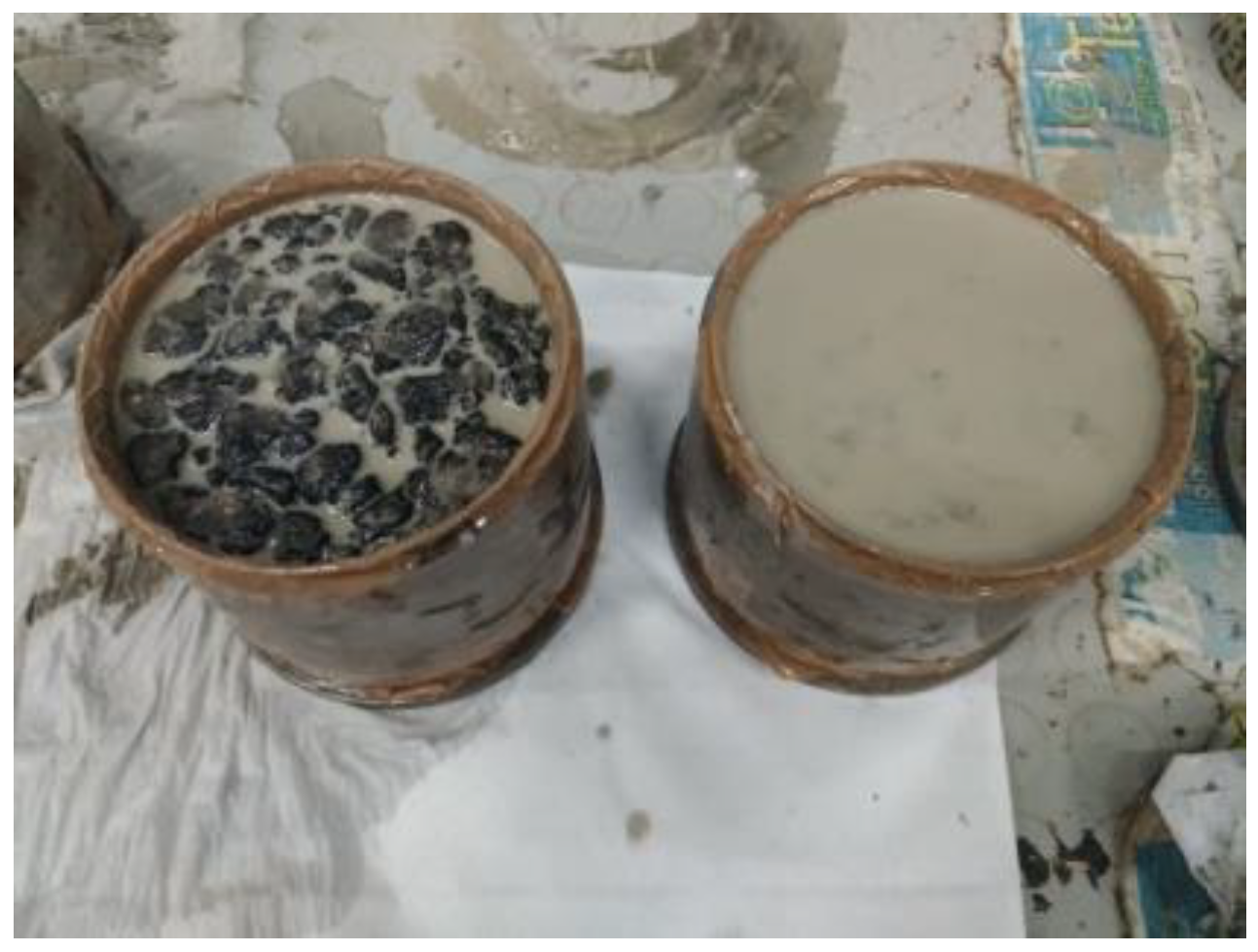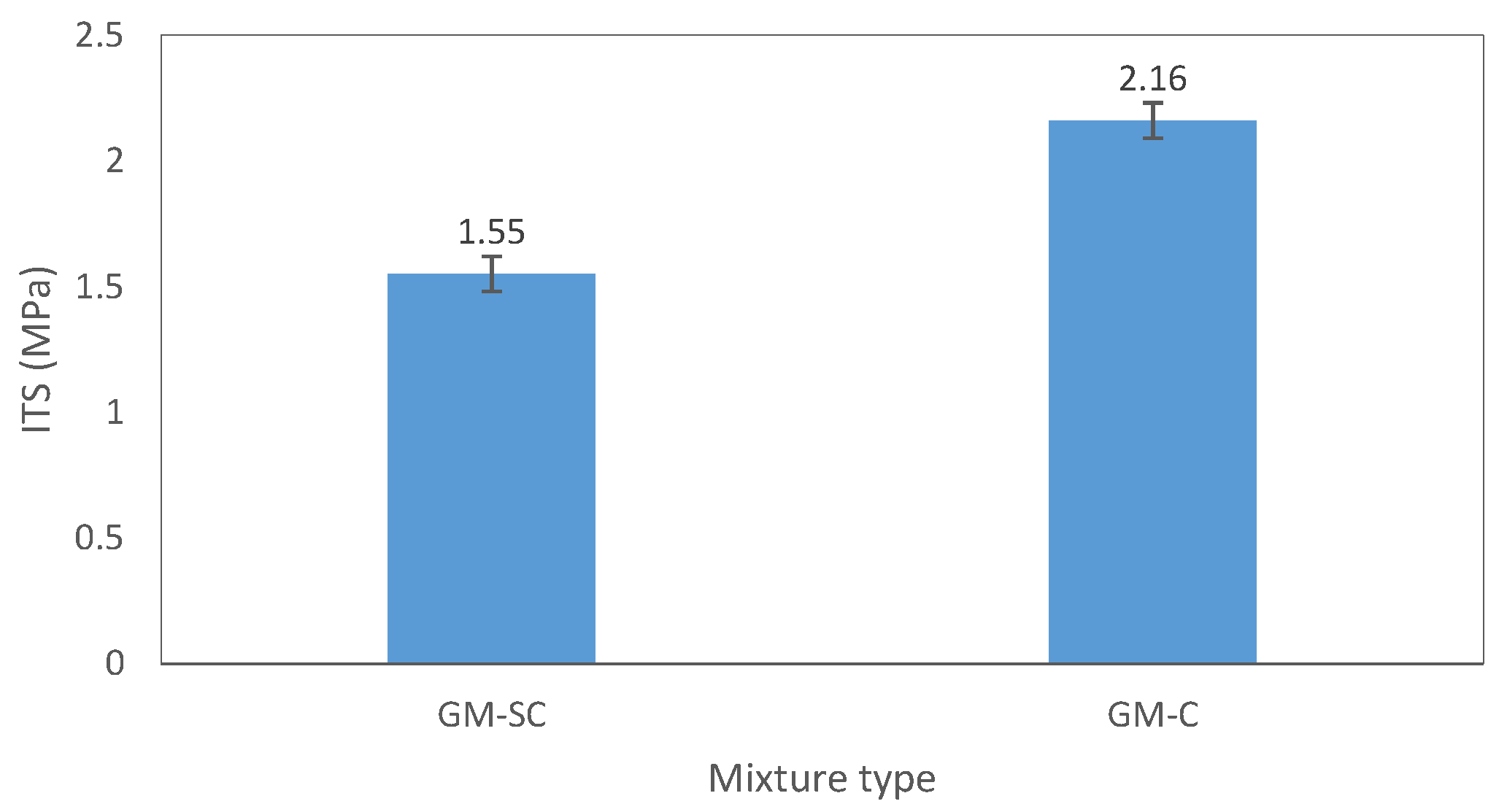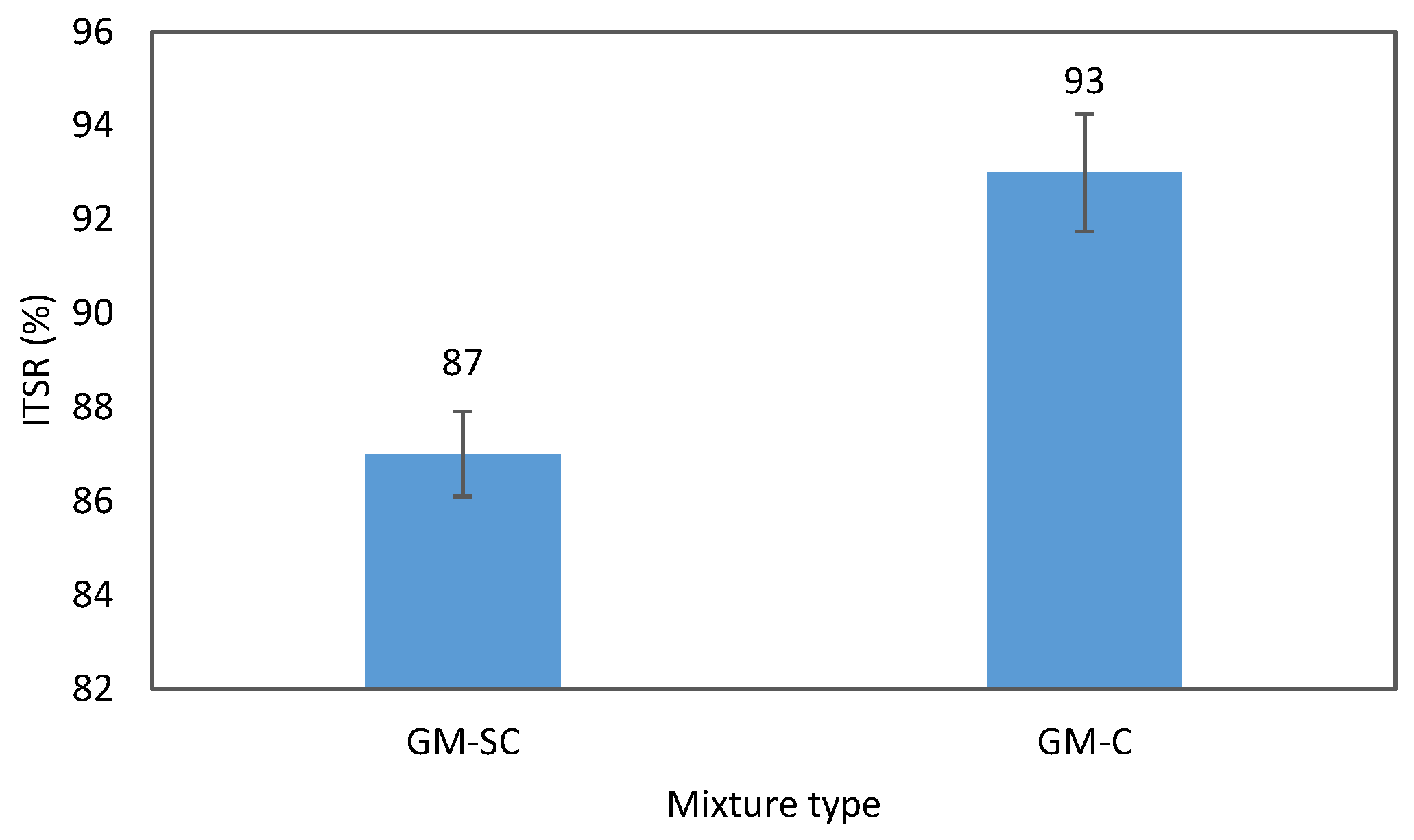Thermally Treated Waste Silt as Geopolymer Grouting Material and Filler for Semiflexible Pavements
Abstract
1. Introduction
2. Materials
2.1. Thermally Treated Waste Silt
2.2. Grouting Material
2.3. Aggregates, Filler, Bitumen and Cellulose Fiber
3. Experimental Program
3.1. Gap-Graded Asphalt Mix Design
3.2. Grout Formulation and Structure
3.3. Grouted Asphalt Concretes
4. Results and Discussion
4.1. Porous Asphalt Mixture Characterization
4.1.1. Indirect Tensile Strength Results
4.1.2. Indirect Tensile Strength Ratio Results
4.1.3. Indirect Tensile Stiffness Modulus Results
4.2. Grouted Macadam Asphalt Mixture Characterization
4.2.1. Indirect Tensile Strength Results
4.2.2. Indirect Tensile Strength Ratio Results
4.2.3. Indirect Tensile Stiffness Modulus Results
5. Discussion
6. Conclusions
- The air-void content of the porous samples was within the suggested range of 25–30%. Thus, the inclusion of thermally treated waste silt as filler does not alter the workability and compactability properties of the porous asphalt concrete.
- The ITS and ITSR values of both porous samples were statistically similar. A slight decrease in the indirect tensile strength was observed when calcined silt was added. However, both values were considerably above the lower cohesion limit suggested for porous asphalt. A similar trend was observed for the ITSR.
- The ITSM values of the control porous asphalt were higher than those of the geopolymer-grouted samples.
- The addition of calcined silt improved the fatigue resistance of the porous mixture at low temperatures compared to the control sample.
- The ITS and ITSR of the grouted mixtures indicated better performance for the control mixture when compared to the experimental one. A drop of approximately 28% was observed when geopolymer was used as the grouting material. The ITSR of the geopolymer was 6.5% lower than that of the control specimen. Due to the lower mechanical performances of the geopolymer-based grouting material, the experimental samples showed lower ITSM values.
- Geopolymer-grouted mixtures showed better low-temperature fatigue properties compared to the control sample.
- Geopolymer-grouted SFP showed lower temperature sensitivity compared to the control grout.
Author Contributions
Funding
Institutional Review Board Statement
Informed Consent Statement
Data Availability Statement
Conflicts of Interest
References
- Generation of Waste by Waste Category, Hazardousness and NACE Rev. 2 Activity (env_wasgen). 2020. Available online: http://appsso.eurostat.ec.europa.eu/nui/show.do?lang=en&dataset=env_wasgen (accessed on 13 June 2022).
- Frosch, R.A.; Gallopoulos, N.E. Strategies for manufacturing. Sci. Am. 1989, 261, 144–153. [Google Scholar] [CrossRef]
- Korhonen, J.; Honkasalo, A.; Seppälä, J. Circular Economy: The Concept and its Limitations. Ecol. Econ. 2018, 143, 37–46. [Google Scholar] [CrossRef]
- Shooshtarian, S.; Maqsood, T.; Caldera, S.; Ryley, T. Transformation towards a circular economy in the Australian construction and demolition waste management system. Sustain. Prod. Consum. 2022, 30, 89–106. [Google Scholar] [CrossRef]
- Xuan Lu, D.; Giustozzi, F. Recycled plastics as synthetic coarse and fine asphalt aggregate. Int. J. Pavement Eng. 2022, 1–16. [Google Scholar] [CrossRef]
- Goli, A. The study of the feasibility of using recycled steel slag aggregate in hot mix asphalt. Case Stud. Constr. Mater. 2022, 16, e00861. [Google Scholar] [CrossRef]
- Titi, H.; Qamhia, I.I.A.; Ramirez, J.; Tabatabai, H. Long-Term Performance of Flexible Pavements Constructed on Recycled Base Layers. Transp. Res. Rec. 2022, 03611981221092000. [Google Scholar] [CrossRef]
- Nwakaire, C.M.; Yap, S.P.; Onn, C.C.; Yuen, C.W.; Moosavi, S.M.H. Utilisation of Recycled Concrete Aggregates for Sustainable Porous Asphalt Pavements. Balt. J. Road Bridg. Eng. 2022, 17, 117–142. [Google Scholar] [CrossRef]
- Kushwaha, P.; Chauhan, A.S.; Swami, B.L. Utilization of waste materials from marble processing industry for sustainable pavement design. Mater. Today Proc. 2022, 63, 547–552. [Google Scholar] [CrossRef]
- Djellali, A.; Laouar, M.S.; Saghafi, B.; Houam, A. Evaluation of Cement-Stabilized Mine Tailings as Pavement Foundation Materials. Geotech. Geol. Eng. 2019, 37, 2811–2822. [Google Scholar] [CrossRef]
- Hassani, A.; Taghipoor, M.; Karimi, M.M. A state of the art of semi-flexible pavements: Introduction, design, and performance. Constr. Build. Mater. 2020, 253, 119196. [Google Scholar] [CrossRef]
- Khan, M.I.; Sutanto, M.H.; Khan, K.; Iqbal, M.; Napiah, M.B.; Zoorob, S.E.; Klemeš, J.J.; Bokhari, A.; Rafiq, W. Effective use of recycled waste PET in cementitious grouts for developing sustainable semi-flexible pavement surfacing using artificial neural network (ANN). J. Clean. Prod. 2022, 340, 130840. [Google Scholar] [CrossRef]
- Cai, X.; Huang, W.; Wu, K. Study of the Self-Healing Performance of Semi-Flexible Pavement Materials Grouted with Engineered Cementitious Composites Mortar based on a Non-Standard Test. Mater. 2019, 12, 3488. [Google Scholar] [CrossRef] [PubMed]
- Davoodi, A.; Aboutalebi Esfahani, M.; Bayat, M.; Mohammadyan-Yasouj, S.E. Evaluation of performance parameters of cement mortar in semi-flexible pavement using rubber powder and nano silica additives. Constr. Build. Mater. 2021, 302, 124166. [Google Scholar] [CrossRef]
- Liew, Y.M.; Heah, C.Y.; Mohd Mustafa, A.B.; Kamarudin, H. Structure and properties of clay-based geopolymer cements: A review. Prog. Mater. Sci. 2016, 83, 595–629. [Google Scholar] [CrossRef]
- Davidovits, J. Geopolymer Chemistry and Application, 4th ed.; Institut Geopolymere: Saint-Quentin, France, 2015; ISBN 9782951482098623. [Google Scholar]
- Davidovits, J. Environmentally Driven Geopolymer Cement Applications. 2002 Geopolymer Conference, Melbourne, Australia, 28–29 October 2002; pp. 1–9. [Google Scholar]
- Thao, A.; Magee, B.; Woodward, D. A preliminary characterisation of innovative semi-flexible composite pavement comprising geopolymer grout and reclaimed asphalt planings. Materials 2020, 13, 3644. [Google Scholar] [CrossRef]
- Hamid Abed, M.; Sabbar Abbas, I.; Hamed, M.; Canakci, H. Rheological, fresh, and mechanical properties of mechanochemically activated geopolymer grout: A comparative study with conventionally activated geopolymer grout. Constr. Build. Mater. 2022, 322, 126338. [Google Scholar] [CrossRef]
- Afonso, M.L.; Dinis-Almeida, M.; Pereira-De-Oliveira, L.A.; Castro-Gomes, J.; Zoorob, S.E. Development of a semi-flexible heavy duty pavement surfacing incorporating recycled and waste aggregates—Preliminary study. Constr. Build. Mater. 2016, 102, 155–161. [Google Scholar] [CrossRef]
- Zhang, Y.; Wang, Y.; Wu, Z.G.; Lu, Y.M.; Kang, A.H.; Xiao, P. Optimal design of geopolymer grouting material for semi-flexible pavement based on response surface methodology. Constr. Build. Mater. 2021, 306, 124779. [Google Scholar] [CrossRef]
- Chen, M.; Lin, J.; Wu, S. Potential of recycled fine aggregates powder as filler in asphalt mixture. Constr. Build. Mater. 2011, 25, 3909–3914. [Google Scholar] [CrossRef]
- Wang, H.; Al-Qadi, I.L.; Faheem, A.F.; Bahia, H.U.; Yang, S.-H.; Reinke, G.H. Effect of Mineral Filler Characteristics on Asphalt Mastic and Mixture Rutting Potential. Transp. Res. Rec. 2011, 2208, 33–39. [Google Scholar] [CrossRef]
- Huang, B.; Shu, X.; Chen, X. Effects of mineral fillers on hot-mix asphalt laboratory-measured properties. Int. J. Pavement Eng. 2007, 8, 1–9. [Google Scholar] [CrossRef]
- Diab, A.; Enieb, M. Investigating influence of mineral filler at asphalt mixture and mastic scales. Int. J. Pavement Res. Technol. 2018, 11, 213–224. [Google Scholar] [CrossRef]
- Sakanlou, F.; Shirmohammadi, H.; Hamedi, G.H. Investigating the effect of filler types on thermodynamic parameters and their relationship with moisture sensitivity of asphalt mixes. Mater. Struct. Constr. 2018, 51, 39. [Google Scholar] [CrossRef]
- Choudhary, J.; Kumar, B.; Gupta, A. Utilization of solid waste materials as alternative fillers in asphalt mixes: A review. Constr. Build. Mater. 2020, 234, 117271. [Google Scholar] [CrossRef]
- Woszuk, A.; Bandura, L.; Franus, W. Fly ash as low cost and environmentally friendly filler and its effect on the properties of mix asphalt. J. Clean. Prod. 2019, 235, 493–502. [Google Scholar] [CrossRef]
- Tarbay, E.W.; Azam, A.M.; El-Badawy, S.M. Waste materials and by-products as mineral fillers in asphalt mixtures. Innov. Infrastruct. Solut. 2018, 4, 5. [Google Scholar] [CrossRef]
- Awed, A.M.; Tarbay, E.W.; El-Badawy, S.M.; Azam, A.M. Performance characteristics of asphalt mixtures with industrial waste/by-product materials as mineral fillers under static and cyclic loading. Road Mater. Pavement Des. 2022, 23, 335–357. [Google Scholar] [CrossRef]
- Nilton de Souza Campelo; Arlene Maria Lamêgo da Silva Campos; Aroldo Figueiredo Aragão Utilization of Synthetic Coarse Aggregate of Calcined Clay in Asphalt Mixtures in the Amazon Region. J. Geol. Resour. Eng. 2018, 6, 321–324. [CrossRef][Green Version]
- Solouki, A.; Tataranni, P.; Sangiorgi, C. Mixture Optimization of Concrete Paving Blocks Containing Waste Silt. Sustainability 2022, 14, 451. [Google Scholar] [CrossRef]
- Solouki, A.; Fathollahi, A.; Viscomi, G.; Tataranni, P.; Valdrè, G.; Coupe, S.J.; Sangiorgi, C. Thermally treated waste silt as filler in geopolymer cement. Materials 2021, 14, 5102. [Google Scholar] [CrossRef]
- Chen, M.; Lin, J.; Wu, S.; Liu, C. Utilization of recycled brick powder as alternative filler in asphalt mixture. Constr. Build. Mater. 2011, 25, 1532–1536. [Google Scholar] [CrossRef]
- Cheng, Y.; Tao, J.; Jiao, Y.; Tan, G.; Guo, Q.; Wang, S.; Ni, P. Influence of the properties of filler on high and medium temperature performances of asphalt mastic. Constr. Build. Mater. 2016, 118, 268–275. [Google Scholar] [CrossRef]
- Hanein, T.; Thienel, K.-C.; Zunino, F.; Marsh, A.T.M.; Maier, M.; Wang, B.; Canut, M.; Juenger, M.C.G.; Ben Haha, M.; Avet, F.; et al. Clay calcination technology: State-of-the-art review by the RILEM TC 282-CCL. Mater. Struct. 2021, 55, 3. [Google Scholar] [CrossRef]
- Tataranni, P.; Sangiorgi, C. Synthetic Aggregates for the Production of Innovative Low Impact Porous Layers for Urban Pavements. Infrastructures 2019, 4, 48. [Google Scholar] [CrossRef]
- Chen, Y.; Xu, S.; Tebaldi, G.; Romeo, E.; Chen, Y.; Xu, S.; Tebaldi, G.; Romeo, E. Role of mineral filler in asphalt mixture. Road Mater. Pavement Des. 2020, 23, 247–286. [Google Scholar] [CrossRef]
- Modarres, A.; Alinia Bengar, P. Investigating the indirect tensile stiffness, toughness and fatigue life of hot mix asphalt containing copper slag powder. Int. J. Pavement Eng. 2019, 20, 977–985. [Google Scholar] [CrossRef]
- Choudhary, J.; Kumar, B.; Gupta, A. Evaluation of engineering, economic and environmental suitability of waste filler incorporated asphalt mixes and pavements. Road Mater. Pavement Des. 2021, 22, S624–S640. [Google Scholar] [CrossRef]
- Marsh, A.T.M.; Velenturf, A.P.M.; Bernal, S.A. Circular Economy strategies for concrete: Implementation and integration. J. Clean. Prod. 2022, 362, 132486. [Google Scholar] [CrossRef]
- Inocente, J.M.; Elyseu, F.; Nieves, L.J.J.; Jiusti, J.; Cargnin, M.; Peterson, M. Applied Clay Science Production and characterization of high-reactivity metakaolins calcined in flash reactor. Appl. Clay Sci. 2021, 213, 106247. [Google Scholar] [CrossRef]
- FLsmidth Revealing the Numbers behind Calcined Clay. Available online: https://www.flsmidth.com/en-gb/discover/cement-2021/revealing-the-numbers-behind-calcined-clay (accessed on 11 July 2022).








| Test | Unit | Value | Standard |
|---|---|---|---|
| Penetration @ 25 °C | Dmm | 25–55 | EN 1426 |
| Softening Point | °C | 70 | EN 1427 |
| Dynamic Viscosity @ 160 °C | Pa.s | 0.4–0.7 | EN 12596 |
| Flash point | °C | 250 | EN ISO 2595 |
| Test | Amount (%) |
|---|---|
| Optimum binder content | 4.2 |
| Aggregates | 90.67 |
| Filler | 4.78 |
| Material | Amount (% Total Weight) |
|---|---|
| Metakaolin | 24 |
| Calcined silt | 16 |
| KOH (solution) | 48 |
| NaOH (8M) | 12 |
| Grout | UCS (MPa) |
|---|---|
| Geopolymer-based grout | 13.9 ± 0.4 |
| Control grout | 38.8 ± 1.5 |
| Specimen | Air Voids (%) |
|---|---|
| PA-C | 26.22 ± 1.86 |
| PA-SC | 25.18 ± 1.09 |
| GM-C | 7.11 ± 1.09 |
| GM-SC | 8.94 ± 2.1 |
Publisher’s Note: MDPI stays neutral with regard to jurisdictional claims in published maps and institutional affiliations. |
© 2022 by the authors. Licensee MDPI, Basel, Switzerland. This article is an open access article distributed under the terms and conditions of the Creative Commons Attribution (CC BY) license (https://creativecommons.org/licenses/by/4.0/).
Share and Cite
Solouki, A.; Tataranni, P.; Sangiorgi, C. Thermally Treated Waste Silt as Geopolymer Grouting Material and Filler for Semiflexible Pavements. Infrastructures 2022, 7, 99. https://doi.org/10.3390/infrastructures7080099
Solouki A, Tataranni P, Sangiorgi C. Thermally Treated Waste Silt as Geopolymer Grouting Material and Filler for Semiflexible Pavements. Infrastructures. 2022; 7(8):99. https://doi.org/10.3390/infrastructures7080099
Chicago/Turabian StyleSolouki, Abbas, Piergiorgio Tataranni, and Cesare Sangiorgi. 2022. "Thermally Treated Waste Silt as Geopolymer Grouting Material and Filler for Semiflexible Pavements" Infrastructures 7, no. 8: 99. https://doi.org/10.3390/infrastructures7080099
APA StyleSolouki, A., Tataranni, P., & Sangiorgi, C. (2022). Thermally Treated Waste Silt as Geopolymer Grouting Material and Filler for Semiflexible Pavements. Infrastructures, 7(8), 99. https://doi.org/10.3390/infrastructures7080099








